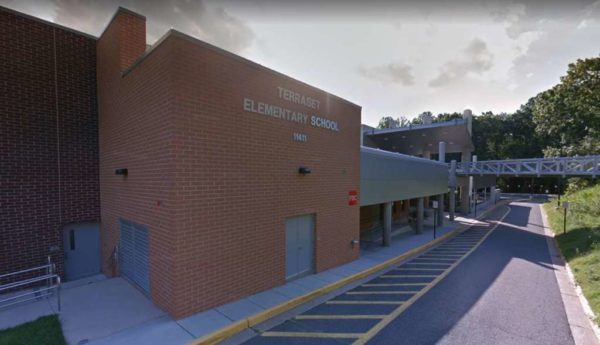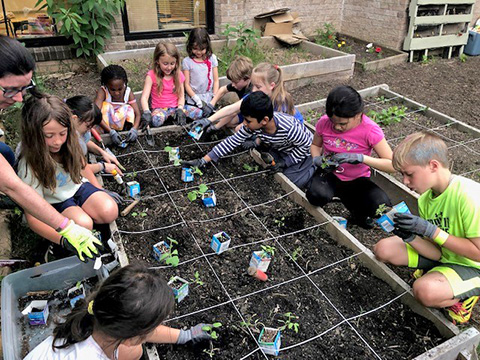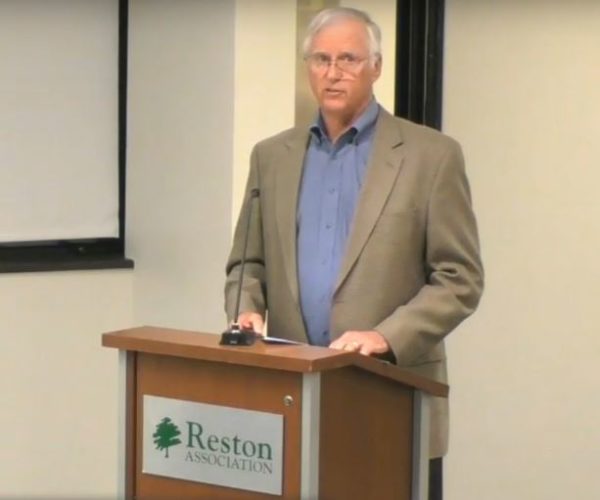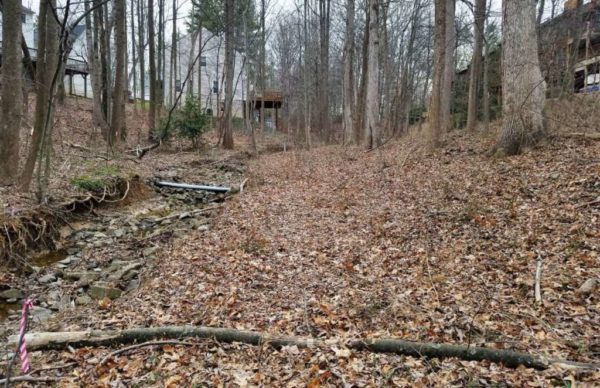Lake Anne Elementary School received its third Eco-school Green Flag, an honor given by the National Wildlife Federation to schools that champion environmental stewardship.
Lake Anne first received the award in 2012 and nabbed two additional awards during the first two years in the program.
Since then, the school has made changes to become more environmentally sustainable.
“Being an Eco-School permeates our school through energy conservation, recycling, water conservation, eco education, our bird houses, and our sustainable garden. Our students are eco stewards every day,” said Principal Jill Stewart.
The school has been involved in many environmentally sustainable projects, as told by Fairfax County Public Schools:
Since 2012, Lake Anne added a pollinator garden, a Monarch butterfly garden, a bird garden for all seasons, a mini meadow, a watershed garden for its dry pond, added solar panels to save energy, added raised beds to the courtyards, and started protecting bluebirds by adding a bluebirds nest box trail. The school also started a community edible garden to provide food for its families in the summer, established and grew a recycling program in the classroom and the cafeteria, participates in walk and roll to school once a month, and started a nature trail in the woods to facilitate nature observation. The school also certified its gardens with the National Wildlife Federation and the Monarch Watch program.
More information about the award is available online.
Photo via FCPS
Reston Boat Rentals — Williams Peterson, the watershed manager for the Reston Association, has information for Restonians about summer boat rentals, including single canoes and kayaks. New this year, boat rentals will be available on July 4 and Labor Day weekend. [Reston Association/YouTube]
Lake Anne ES Students Protecting the Planet — “Lake Anne Elementary’s Eco-School team was invited to present at the second annual Student Innovation Showcase… students were able to share their work on protecting the environment.” The school will receive $2,581.82 in grants this spring for to improve the existing learning gardens, create an herb garden and composting system, create a nature trail and more. [Fairfax County Public School]
Office Evolution Coming to Herndon — “Office Evolution is now bringing what it calls a workplace revolution to Herndon with a 6,400 square-foot center on Van Buren Street that opened on Mar. 15, becoming the company’s second franchise in Fairfax County along with an existing Tysons Corner location.” [Fairfax Times]
Herndon Students Say “Au Revoir” to French Immersion Program — “May 31 [was] an occasion of mixed feelings for everyone involved with Herndon Elementary School’s French immersion program. Past and present students, teachers, and parents [gathered] that day to celebrate the program’s 30th anniversary, but the event [was] a final send-off, as Herndon Elementary will no longer offer French immersion after this academic year ends in June.” [Fairfax Times]
 This is an opinion column by Del. Ken Plum (D), who represents Reston in Virginia’s House of Delegates. It does not reflect the opinion of Reston Now.
This is an opinion column by Del. Ken Plum (D), who represents Reston in Virginia’s House of Delegates. It does not reflect the opinion of Reston Now.
Advocates on behalf of cleaning up our environment got further strong evidence of the need for “bold, swift action on behalf of our environment,” a phrase used by many who have recently written letters to me. A 1,500-page report based on thousands of scientific studies by hundreds of international experts has concluded that “humans are transforming earth’s natural landscapes so dramatically that as many as one million plants and animal species are now at risk of extinction posing a dire threat to ecosystems that people all over the world depend on for their survival.”
The Intergovernmental Science-Policy Platform on Biodiversity and Ecosystem Services that produced the report for the United Nations found that “piecemeal efforts to protect individual species or to set up wildlife refuges will no longer be sufficient.” Instead, they call for ‘transformative changes’ that include curbing wasteful consumption, slimming down agricultures and cracking down on illegal logging and fishing.” The writers of the assessment are hoping that policy makers will see the importance of nature to the health of people and local economies and will able “to strike a more careful balance between economic development and conservation.”
As Virginia advocates point out in their plea, “it will now be up to the 2020 Virginia General Assembly to stand up for our health and the environment, for clean energy, and to protect Virginians from the ravages of climate change of which we are already feeling the effects.” The most recent session of the General Assembly demonstrated that the legislators in charge can make all the difference. In a strictly partisan vote, the Republican majority had language inserted in the budget that restricts the Commonwealth’s ability to participate in the Regional Greenhouse Gas Initiative (RGGI) that will be a critical avenue for reducing carbon emissions in the state and addressing the negative effects of climate change on the health and safety of the people.
While the language by the Republicans was not subject to a line item veto by the Governor because of past court decisions, the Governor nonetheless has pledged to move forward with new regulations much the same as would be part of RGGI to make significant reductions in carbon pollution from fossil fuel fired power plants. The Governor has made it clear that the budget he prepares next year will delete the Republican language. With the probable change of control of the House of Delegates and State Senate this year the language will not be carried forward in future budgets.
It is unfortunate that the actions of the Governor on this and other items in the budget have been sharply criticized because of a misunderstanding on the part of many that the Governor’s line item veto power is not unlimited — supported by court decisions but still controversial. The good news is that the Governor has indicated in many other actions that he recognizes the need for bold and swift action to protect our environment. I look forward to working with him in greatly enhancing Virginia’s protection of the environment.
File photo
Fatal Pedestrian Crashes Exceed Murder Rate in Fairfax County — Local officials are asking the public to avoid distracted driving in order to help prevent cyclists and pedestrians from being killed on the road. [WTOP]
‘Before the Flood’ Screening Tonight — The film follows actor Leonardo DiCaprio as he interviews scientists, activists and world leaders about climate change. The screening, which is part of an annual environmental film series, takes place at the Walker Nature Center from 7-9 p.m. Walk-ins are welcome. A donation of $5 is suggested. [Reston Association]
County Proposal to Pay Legal Fees for Residents Facing Immigration Enforcement –– “As the Fairfax County Board of Supervisors approaches the May 7 deadline for budget adoption, one of the more intriguing, and potentially polarizing, items under consideration is a pilot program that would fund legal representation for county residents subject to federal immigration enforcement actions.” [Fairfax County Times]
Flickr pool photo by vantagehill
The U.S. Army Corps of Engineers is considering a proposal to widen a three-mile stretch on Route 7 from four to six lanes.
The project, which runs from Reston Avenue to Colvin Run Road, would require the removal of just under one acre of wetlands and 2,196 linear feet of streams — the equivalent of a little over seven football fields. Shirley Contracting Company, the applicant, is attempting to minimize the environmental impacts of the project by shifting the proposed realignment by several feet. This shift would save nearly three acres of wetlands and preserve 109 linear feet of streams, according to the U.S. Army Corps of Engineers.
Still, Shirley Contracting Company will have to provide roughly 1.9 acres of wetland credits and 2,101 feet of stream credits to offset the impact of the project on the environment. Credits are a way to create compensatory mitigation to ensure ecological losses to streams and wetlands do not result in a net loss of natural resources.
Intersection improvements, the replacement of the bridge over Difficult Run, shared-use paths, utility relocations and stormwater management are also planned. Roughly 1,600 linear feet of Colvin Run, which runs parallel to Route 7, will also be relocated.
The U.S. Army Corps of Engineers will issue a permit for the project if it determines the project is in the public interest. “The decision will reflect the national concern for both protection and utilization of important resources,” according to the U.S. Army Corps of Engineers. The project must also get a green light from the Virginia Department of Environmental Quality.
The public comment period ends on May 24. Written comments can be sent to [email protected] or by mail to Norfolk District, Corps of Engineers (ATTN: CENAO-WR-R), 803 Front Street, Norfolk, Virginia 23510-1011).
Map via U.S. Army Corps of Engineers
This week on Then and Now, we’re going back to South Lakes to take a look at Lake Audubon.
With help from Fairfax County’s Historic Imagery Viewer, which offers aerial views of the county dating back to 1937, Reston Now has put together a look at how the lake has evolved from overhead and under the surface.
Audubon is the largest of Reston’s lakes in both it’s acreage — 43.5 acres — and it’s extensive watershed covering 1,558.5 acres.
While Lake Thoreau holds 26.5 million gallons of water, it’s southern twin holds 133.6 million gallons.
Lake Audubon and Lake Thoreau were conceived to be one lake, then named Lake Elsa. The lake was impounded in 1971 and was named for Reston founder Robert Simon’s mother.
But in 1979 the South Lakes dam bisected the property and split the lake, creating Lake Thoreau in the North and Lake Audubon in the south.
For years, the southern area closed off by the dam, but for years afterwards remained a dry pit. During the 1980s, the lake was filled in with water.
But while the lake shows very little change from above between 1997 and 2017, there were plenty of changes taking place beneath the water’s surface. In those years, several new species of aquatic wildlife was introduced to the lake, including:
- Redear Sunfish
- Black Crappie
- Brown Bullhead
- American Eel
In more recent years, the levels of contamination in the water continue to be a problem, caused in large part by the lake’s large surface area. According to a 2017 report on Reston’s lakes, Lake Audubon’s has faced increasing amounts of toxic algae that pose an ecological threat to the lake.
Increasing levels of toxic algae culminated with a warning to local residents to avoid contact with the lake, leading to a dredging project earlier this year.
For more Reston Then and Now, check out:
Road salt may have a hand in the recent spikes of chloride concentrations in Reston streams, along with a slew of environmental issues.
Doug Britt, a member of the Reston Association’s Environmental Advisory Committee, recently examined environmental harm caused by de-icing agents including sodium chloride and dove into results from monitoring Difficult Run and Sugarland Run with fellow Restonians.
Britt wrote that measurements of the chloride concentrations at the two sites were taken before this year’s first storm and then again after road salting for the first two snowstorms. He found that the chloride concentrations at both sites increased fourfold from the first measurement, which he said was within the normal range for North American streams.
The monitoring efforts were a part of a larger program initiated by the Izaak Walton League of America to encourage “citizen scientists” to examine local streams before and after road salting.
Britt, a Virginia Master Naturalist member, wrote that higher chloride concentrations in lakes and ponds can halt the bottom and top waters from mixing, which then leads to less oxygen in deeper areas. Too much chloride can reach toxic levels for aquatic life.
“Although there are a number of alternative de-icing agents available, sodium chloride as a brine solution appears to have the least negative environmental impact when considering the full life cycle of its production and application,” the report says. “Sodium chloride, nevertheless, can generate a host of environmental problems.”
Britt’s report analyzed several of those impacts, which included:
- water quality
- soil
- pets
- wildlife
- roadside vegetation
- infrastructure
Britt says that these environmental concerns aren’t unique to Reston.
“Chloride concentrations in Fairfax County surface waters have steadily increased for the past 25 years, consistent with the use of de-icing agents,” Britt wrote.
Britt ended his report on information about the next step: action.
The Virginia Department of Environmental Quality is currently developing a Salt Management Strategy planning process aimed at keeping chloride levels below the amount that starts to ruin the water, the report says.
The department also had had in a 2018 report included suggested options to optimize de-icing agents and the way they are applied to reduce environmental impacts, Britt wrote.
“Meanwhile, as individuals and business owners we should be cognizant of the potential environmental impacts associated with the application of de-icing agents,” Britt wrote, adding that it is important to balance public safety with environmental damage.
Photo via Reston Association
 This is an opinion column by Del. Ken Plum (D), who represents Reston in Virginia’s House of Delegates. It does not reflect the opinion of Reston Now.
This is an opinion column by Del. Ken Plum (D), who represents Reston in Virginia’s House of Delegates. It does not reflect the opinion of Reston Now.
Despite all the distraction associated with events in Richmond these days, the General Assembly is staying on task dealing with legislative and budgetary issues it faces.
Each house of the legislature has started to work on legislation passed by the other with conflicts resolved in conference committees made up of members from both houses. The really big conference committee is working to resolve differences on the budget. The big differences on the budget are between the Democrats and Republicans and not the two houses — how to deal with additional revenues coming to the state from the federal tax changes. Stay tuned for the differences on the budget because they will not be resolved until the last few days of the session that is scheduled to adjourn on Feb. 23.
Some good news is emerging from the session. Requiring hands-free phones in cars has been required in most other states many years ago and may finally be coming to Virginia. Research shows that the greatest cause of auto accidents is distracted driving with calls and texting being the chief reason.
I remember the many sessions that it took to pass requirements for smoke-free areas. Richmond as the cigarette manufacturing capital was finally over-ridden by popular sentiments, and smoke-free areas were legislated. Amazingly but happily the age to buy cigarettes and the latest craze of buying electronic vaping devices is being raised from age 18 to 21.
Efforts to legalize gambling establishments in areas of the state as diverse as Portsmouth, Bedford and Danville failed this year in favor of a year-long study to determine state policy. I predict we will see casinos established in the state in a few years as some regions see them as economic development and a source of new revenue offsetting anemic state funding. I voted to let a study go forward but would not support public financing of a stadium or gambling establishment.
Bills that would have decriminalized marijuana did not make it out of committee in either house. My bill introduced at the suggestion of the Chris Atwood Foundation to make Naloxone more available to reduce deaths from drug overdoses passed.
Different bills passed that purport to create a fairer way to draw legislative district boundaries, but neither comes close to the independent processes that the public has been seeking to end gerrymandering.
On the environment, bills to require Dominion to clean up their coal-ash ponds passed both houses with endorsement by major environmental groups. A bill I voted for that would have established an ambitious agenda for cleaning up the environment in Virginia failed in the House.
The Senate passed a bill to require public schools to teach a class on the Bible! I will not be voting for it if it makes its way through committee.
All the gun safety bills were defeated in both houses. A bill to make it easier to get a concealed weapon if you are from another state passed with a likely veto by the governor.
Yes, there are other big challenges in the capital these days. I will be addressing them in future columns as the facts involved become better known.
File photo
 Hunter Mill District Supervisor Cathy Hudgins used her newsletter this month to give a glimpse into her “difficult decision” behind her decision to not run for re-election to the Fairfax County Board of Supervisors.
Hunter Mill District Supervisor Cathy Hudgins used her newsletter this month to give a glimpse into her “difficult decision” behind her decision to not run for re-election to the Fairfax County Board of Supervisors.
Hudgins, who is nearing the end of her fifth term, was first elected to the board in 1999. Her retirement announcement came during the Board of Supervisors meeting last month, adding to the list of supervisors who have also said they are leaving.
Now in her 20th year on the board, Hudgins used the newsletter as an opportunity to share her priorities for a “vigorous” year, including renewable energy and Silver Line Phase 2’s progress.
Here is her full note:
Dear Hunter Mill Friends,
On Jan. 22, during the first Board of Supervisors (BOS) meeting in 2019, I was struck by the thought: I am beginning my 20th year as Hunter Mill Supervisor with the mixed emotions of excitement and joy in serving the community and the reality that even good things must end. At that moment, I felt compelled to speak and share my intention not to seek reelection to be the Hunter Mill District representative. Believe me it was a difficult decision and an equally difficult announcement. However, I do intend to have a vigorous 20th year and continue to enjoy the kind of work that we’ve been able to do with this board.
One thing that will greatly contribute to a vigorous year is an improved public transit system, connecting the Metrorail system to Dulles International Airport and points in Loudoun County. I am excited to share that the first trains rolled along the Silver Line Phase 2 tracks around 1 a.m. on Wednesday, Feb. 6. The test train traveled from Wiehle-Reston Station to Innovation Station at a speed of about 15 mph! There is an interesting story behind that spectacular speed. Because the third rail is not yet electrified for this test, the trains were pushed by a small diesel locomotive. Once the rail polishing phase — necessary to remove rust that can accumulate on unused rails — is complete, additional trains, equipped for Safe-Braking and Control-Line Communications trials, will begin the “dynamic testing” process. This is required before the rail line begins commercial operation.
This testing work, is a significant milestone and will continue for several months before public service commences in 2020.
Another area of significant relevance and impact is the environment. In 2017, the BOS adopted an Environmental Vision “to promote and encourage energy efficiency and conservation efforts and renewable energy initiatives by county employees, employers and residents.” In 2018, the board adopted an Energy Strategy for county operations with the goal of
reducing “fossil fuel consumption through the application of innovative concepts & technologies.” In 2019, the BOS is raising awareness of its achievements already made — two Solarize campaigns conducting free on-site solar assessments that led solar panel installations, totaling 398 kW — and the county commitment to a third campaign in the spring of 2019. With the assistance of the SolSmart program, we will do just that. SolSmart is a national designation program for solar friendly communities, their commitments, and their accomplishments.Moreover, Fairfax County is committed to improve solar market conditions, making it faster, easier and more affordable for residents and businesses to install solar energy systems. Currently, the county is considering the creation of a local Commercial Property Assessed Clean Energy (C-PACE) program. Depending on the ordinance language, a C-PACE loan
could finance energy efficiency and renewable energy improvements on industrial, commercial, agricultural, multi-family and non-profit/religious properties. So as you can surmise, it will be another busy year.In closing, I would like to acknowledge that representing the Hunter Mill District continues to be challenging and thrilling and I am looking forward to a dynamic 2019 indeed. It is an ongoing honor to serve and I fully intend to continue being engaged with the work of the community.
— Cathy Hudgins
File photo

Students at Terraset Elementary School are reducing their plastic use — one straw at a time.
Since the beginning of the year, students are no longing using single-use straws in the cafeteria. Fairfax County Public Schools announced on Tuesday (Jan. 15) that the straw initiative is saving up to 400 straws per day.
An estimated 80,000 straws will be eliminated over the period of one school year.
In addition to the single-use straw ban, Terraset is now encouraging students to trade disposable water bottles in for reusable ones and to use canvas totes instead of plastic bags.
The school’s initiative and recent urging are meant to help students make environmentally-friendly choices.
“Terraset’s students are helping to save the planet and oceans by individual actions that make a big difference,” according to an FCPS press release.
Image via Google Maps
 This is an opinion column by Del. Ken Plum (D), who represents Reston in Virginia’s House of Delegates. It does not reflect the opinion of Reston Now.
This is an opinion column by Del. Ken Plum (D), who represents Reston in Virginia’s House of Delegates. It does not reflect the opinion of Reston Now.
In a recent social media post, I indicated that the annual General Assembly session would be underway very soon. AutoCorrect changed the text to be “underwater very soon.” My son alerted me to the change, and I made what I thought was a correction. As the General Assembly session has gotten underway I am starting to wonder if AutoCorrect knew something that I am now coming to realize: the General Assembly may well be underwater!
The session is scheduled to go until Feb. 22. Meeting five days a week means 38 actual days for work on more than 2,000 bills and resolutions. While I have highlighted big issues like redistricting reform, preventing gun violence and ERA ratification, there are many more issues large and small that make up the agenda for the session.
Virginia has always conformed its income tax policies to the federal system. With the massive changes that have been made in federal tax law, the General Assembly will wrestle with what we will do in Virginia. There will be an effort to resolve the issue early in the session to accommodate taxpayers who want to file their returns early. Part of the tax policy debate will be making the Earned Income Tax Credit (EITC) refundable as promoted by the governor in a bill that I have introduced. The purpose would be to allow persons of low income to keep more of the money they earn and be more self-supporting.
As a Dillon Rule State — meaning local governments have only the powers granted to them by the state — dozens of bills called “local bills” are introduced to extend powers some of which are very minor to a particular locality. Another group of bills is called “housekeeping” to make corrections or clarifications to legislation that passed in previous sessions. All these bills are important but add to the workload of a session.
Challenging environmental issues will be coming before the legislature many of which relate to energy. There are proposals to increase the required uses of alternative and renewable fuels. Cleaning up from the past use of fossils fuels and the resulting growth in coal ash ponds will be taken up. There is a strong need to deal with the degradation of water quality in the Chesapeake Bay area. The Tidewater area is subject to recurrent flooding coming about with climate change that needs addressing now rather than later.
There are many bills dealing with criminal justice reform including bills intended to reduce the school to prison pipeline. The governor has announced his support of decriminalizing possession of small quantities of marijuana. A bill that has been introduced would allow casino and sports gambling.
There will be a number of dog and cat bills that include high levels of emotion from interested parties. Being able to limit dogs running across the properties of landowners is a big concern in rural areas.
You can review all the bills on the agenda of the General Assembly.
If you have not done so already, let me know your positions on issues by going to my website and click on Legislative Session Survey.
File photo
An environment-focused nonprofit has raked in funding for long-awaited community garden plots at Bruin Park.
The Fairfax County Park Authority Board approved a funding request from the Herndon Environmental Network (HEN) for $20,000 at its Nov. 14 meeting.
HEN will use the grant money to help develop 40 garden plots on the west side of the tennis courts at the park, which is located at 415 Van Buren Street. The plan also includes adding fencing to protect the plots and accessible trails, according to a county press release.
The project’s budget totals $42,496.22 — a combination of the grant money with a $7,966.06 cash contribution and $14,530.16 of in-kind donations from HEN.
Plans for the community garden sprouted several years ago.
The Master Plan for Bruin Park was amended in January 2014 to allow for community garden plots. In April 2017, an agreement between HEN, the Town of Herndon — which owns the park — and the Park Authority authorized HEN to develop, manage and maintain community garden plots at the park, according to the press release.
HEN is set to celebrate the grant award at the monthly Bruin Park Community Garden planning meeting — free and open to the public — at 7 p.m. on Dec. 13 at the Herndon Fortnightly Library.
The Reston Association’s Board of Directors received a summary last week of the second annual report about the state of the environment in Reston.
Doug Britt, a Virginia Master Naturalist and the director of Reston Association’s first Reston Annual State of the Environment Report, gave an overview of the 2018 Annual State of the Environment Report (RASER) at a Reston Association meeting on Thursday (Nov. 15).
The study is intended to give readers a better understanding of Reston’s current environmental conditions in order to provide a baseline against which future changes to the environment can be measured.
The second RASER updates all of the topics addressed in the first one, along with adding new topics and recommendations. The results of the first RASER arrived in January after it was published last July.
The report has 11 new recommendations, which include the following:
- Schedule dredging when nuisance aquatic weeds are dormant
- Enforce shoreline distribution regulations for cluster shoreline properties
- Create a plan to alert residents about lake safety issues
- Assess whether de-icing salts are affecting water quality
- Partner with organizations to conduct native plant education programs, to use edible plants in landscaping and to distribute leftover food
- Determine baseline noise levels throughout parts of Reston
The report also has an analysis of 19 environmental attributes — rating them on a scale of green (good), yellow (fair), red (poor) and undetermined — and adds in excerpts from Fairfax County’s Environmental Vision Document. “I feel confident as a community that we are way ahead of a lot of other county committees in meeting the revised vision document of the county,” Britt said.
Attributes that got a “green” rating include air quality, drinking water, wastewater treatment, hazardous and toxic waste and environmental education.
Streams received a bump from “red” to “yellow” status this year after more diversity than expected was found in them over the summer, Britt said, adding that almost half of Reston’s streams have been restored. Lakes and ponds, urban forests, landscaping, wildlife management and light pollution also got bucketed in the “yellow” rating.
Attributes that lacked enough data for an adequate rating included wetlands, mammals, reptiles and amphibians, invertebrates and noise pollution.
Only one received the “red” designation: stormwater management. “When Reston first developed in the early 60’s and 70’s, the stormwater was typically shunted from development sites into nearby receiving sites as quickly as possible trough impervious surfaces,” Britt said. “This resulted in the streams not being able to handle the capacity of storm surges.”
South Lakes District Director Julie Bitzer said at the meeting that she has had a lot of residents talk to her about erosion and stormwater management, because of the amount of rain this year. “I think that is something we need to look at,” she said.
Britt encouraged the board to move away from the “band-aid approach” of expensive lake dredging to remove sediment and instead focus on soil erosion prevention, which he said will be a more cost-efficient choice for improving streams and water quality issues. He also suggested that the board empower residents to help by using low-technology solutions like rain gardens and also set higher standards for developers.
Britt also provided a breakdown of the progress of the 61 recommendations made in last year’s report. Two have been completed, while the rest include 14 lacking progress, 20 with limited work done and 25 with “substantial” progress.
“I don’t want anybody to get the idea that because only two were fully completed, that this designates some ignoring of these recommendations, because very few of the recommendations were what I would call ‘one and done,'” he said.
The three highest priorities should be protecting Reston’s urban forests, improving surface water quality and maintaining “robust” education and outreach programs, Britt said.
RASER recommendations will continue annually, while updates will come every other year, Britt said. The next updated text is expected to be released in 2020.
Photo via Reston Association/YouTube
Plans to restore roughly 800 linear feet of Lake Audubon’s streams were approved by Reston Association’s Design Review Board Tuesday night. The project, called Snakeden, would involve tree removal, stream construction and revegetation along RA’s parcels between Cedar Cove Cluster and Wakerobin Lane.
Meghan Fellows, the county’s manager of watershed projects, said a design team has been working on the project, with the input of RA, property owners and residents, for nearly three years.
“The stream is desperately in need of some assistance,” Fellows said at the DRB meeting, noting that portions of the area are degrading significantly.
Richard Newlon, the board’s chairman, said he hopes the project team will minimize the loss of trees by tweaking designs and implementation to conserve trees — even if it meant a minor tweak to save just one tree.
The project was challenged by the need to secure easements across private property and Reston Association property to construct the stream. Land rights for the project were obtained in June following a more than a year-long period of tree and stream surveys and conceptual planning.
After a cycle of revisions, permits were granted in October. After receiving final approval for designs, drawings and permits in the spring of next year, construction is likely to begin in the summer, Fellows said.
Overall, several sanitary crossings in the area are exposed and RA found that 40 trees are likely to fall down if no action is taken. Trees will be replanted during later phases of the project.
County staff estimates the project will cost under $1 million.
Photos via handout/Reston Association
 This is an opinion column by Del. Ken Plum (D), who represents Reston in Virginia’s House of Delegates. It does not reflect the opinion of Reston Now.
This is an opinion column by Del. Ken Plum (D), who represents Reston in Virginia’s House of Delegates. It does not reflect the opinion of Reston Now.
If the 91 scientists from 40 countries who analyzed more than 6,000 scientific studies on climate change are to be believed, the dire consequences of climate change will be felt as soon as the next couple of decades, within the lifespan of most of the readers of this column.
Do exaggerated weather conditions of hotter temperatures, excessive rains and winds with more hurricanes and tornadoes, droughts over many years for some regions, wildfires covering thousands of acres as well as the death of the coral reefs and some wildlife sound familiar along with recurrent flooding and disappearance of some beaches? All of these are signs of climate change.
The warning from the United Nations Intergovernmental Panel on Climate Change is the second in as many decades. Will it be heeded? Many policymakers will not be around to feel the consequences of inaction, but what about the old-fashioned notion that we have a responsibility for future generations including our own progeny? Should we try to save the planet for them? Any one action by an individual will not change the course we are on with changes to our climate, but the serious and collective actions on the part of most citizens have the potential to make a difference.
I have heard arguments from those who take a religious view of the issue that they do not believe that the god they worship as the creator of the world would let humankind destroy it. Could it be that the same God who gave humankind dominion over the planet would have an expectation that we would be good stewards of the resources and protect them?
I support a total reversal of the insane policies on climate change of the current federal administration. I abhor this administration’s policies and practices to ignore the clear warnings and to pursue environmental rules based on personal and corporate strategies to make a monetary profit or to gain votes from a constituency. As I discussed in this column in prior weeks, I plan to provide leadership on issues at the state level that will curtail and reverse actions furthering climate change.
Now it is up to us individually to live our lives in a way that shows our mindfulness of the effects of climate change and our willingness to make changes ourselves that will start to reverse the damage. As consumers, we need to reward businesses that pursue climate awareness policies and actions and to not deal with those whose manufacturing processes and actions contribute to climate change.
We need to buy energy from renewable sources even if may cost more. We need to live in such a way that enhances the health of the natural elements around us. We need to plant more trees that can have a great impact on greenhouse gases. We need to walk or bike more and drive internal combustion engine vehicles less.
Who’s in with me? Let’s prove the scientists wrong by changing the way we live in order to preserve our planet. If it is too late for you, what about your grandchildren and their children?
File photo









